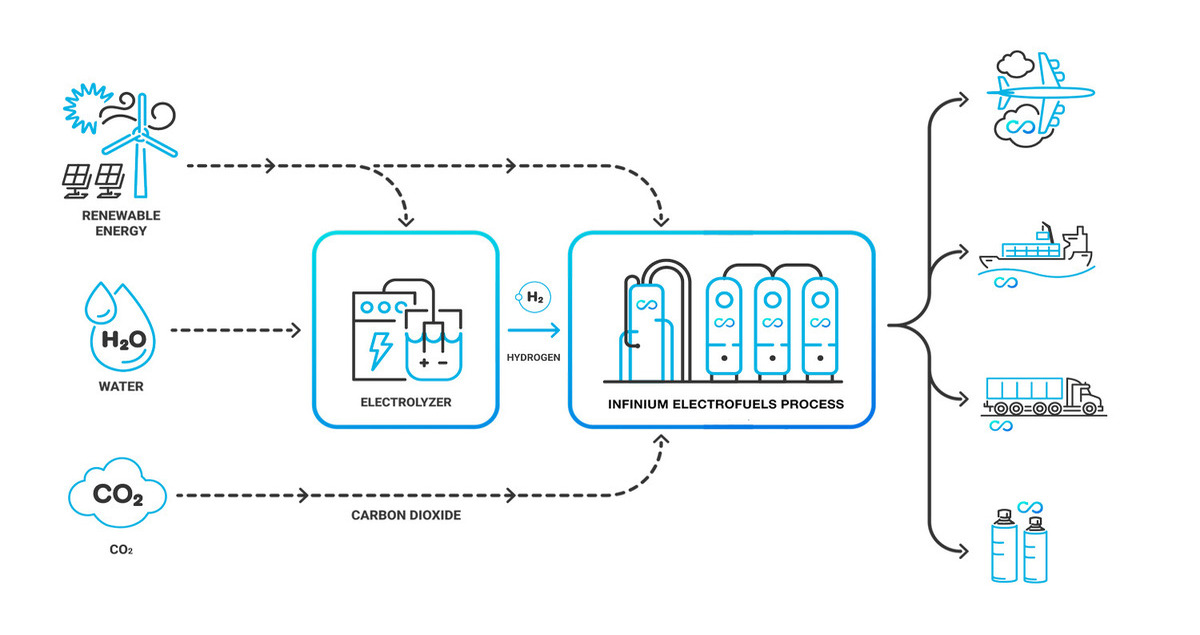What are e-fuels and can they help decarbonization?

Travel remains an integral part of the human experience and a fundamental means of learning and discovery. Now that we know many existing methods of travel are environmentally unsustainable, the transport industry is in the process of orchestrating one of the biggest energy pivots of any sector.
However, the scale of the task is truly global, and transport has a challenging paradox to deal with: population and worldwide economic growth are increasing demand, but at the same time there is a pressing need to reduce emissions — and all in a sector that has the single highest reliance on fossil fuels of any industry.
E-fuels — or electrofuels — are likely to be part of a range of solutions to accelerate decarbonization of the transport sector. But how are they made and are they a feasible option for reducing the carbon emissions of what are hard-to-electrify industries?

What are e-fuels and how are they made?
E-fuels are synthetic fuels produced through electrolysis, a process that splits water molecules into hydrogen and oxygen using renewable electricity. Green hydrogen produced through electrolysis is reacted with CO2 captured from various sources in a process known as synthesis. This results in a synthetic hydrocarbon fuel, or e-fuel.
And because they can be a drop-in replacement for existing combustion engines, one major attraction of e-fuels is their immediate impact on reducing CO2 emissions without needing upgrades or new machinery.
The e-fuel market is in its infancy, but using this synthesis of hydrogen and CO2 instead of fossil fuels — which make up around 95% of all fuels currently used in transport — is a highly tempting proposition for a sector that has limited decarbonization options.
Who is developing e-fuel technologies?
Leading companies and research institutions worldwide are already investing in the development of e-fuels. Major players in the energy and transportation sectors — from vehicle makers to oil companies — are actively exploring e-fuel technologies.
In Sweden, Vattenfall, SAS, Shell and LanzaTech are working together to produce 50,000 tonnes a year of synthetic sustainable aviation fuel (SAF). While in Norway, the airline Norwegian has teamed up with Norsk e-Fuel to build the world’s first full-scale e-fuel plant.
Collaborations between academia, government bodies and private enterprises are driving innovation, focusing on improving efficiency, scalability and cost-effectiveness.

The benefit of e-fuels is that they can be used in today’s vehicles as a replacement for fossil fuels without any required engine modifications. US-based firm Infinium produces a range of proprietary ultra-low carbon e-Fuels, including eSAF, e-Diesel and e-Naphtha, which will soon be powering Amazon’s trucking fleet. Mitsubishi Heavy Industries (MHI), which is an investor in Infinium, is also working with the start-up to bolster its CO2 capture efforts.
Are e-fuels carbon neutral?
One of the key advantages of e-fuels is their potential for carbon neutrality. The use of renewable electricity during the electrolysis process means the production of hydrogen is free from direct greenhouse gas emissions. And, if the CO2 used in the process is captured from biomass sources or directly from the atmosphere, the carbon emissions from combustion can be balanced out by the carbon captured.
Which sectors can e-fuels help to decarbonize?
E-fuels show particular promise for some areas of transport that require high energy density and are hard to electrify. Aviation and shipping — which need energy-dense fuel — are a natural fit, particularly since the success of electrification for long-distance transport in both sectors is contingent on making the batteries more energy-dense than is currently achievable.

On land, while electric vehicles are rapidly gaining popularity, long-haul trucking still requires an alternative to electrification. Electrifying long-distance trucks, or even construction equipment or farming machinery is problematic, as all of these vehicles need to be able to run for long periods and have high energy requirements. Using e-fuels is a more viable route to accelerate the decarbonization of long-haul transport and heavy machinery.
What challenges do e-fuels need to overcome?
The cost of producing e-fuels currently far exceeds that of producing fossil fuels. Given e-fuels are an emerging market, economies of scale are not yet in full effect, nor have the necessary infrastructure investments for commercial production, distribution and storage been made. That means there is more capital required but it also means costs should fall accordingly over time.
Producing e-fuels also involves a lot of energy conversion steps, from electricity to hydrogen and then from hydrogen to the final e-fuel, all of which result in energy loss. The overall efficiency of the production chain needs to improve to a point where energy inputs can be justified by the emission reductions they provide.
Legislation that encourages the use of e-fuels will be critical to their widespread adoption, and clear, long-term policies will create a confident investor environment that should speed up deployment and development of e-fuels.
E-fuel technology is already here and in the process of becoming commercially viable. Cost and efficiency issues make the value proposition more challenging. Still, with supportive policies, efficiency gains and investment, e-fuels could contribute to unlocking ultra-low or no-carbon transport for generations to come.





